Pines, like other classes of conifers, are wonderful material for a landscape designer. Their high decorativeness, plasticity and a variety of forms give great scope for creativity. One of the most attractive species is the Weymouth pine. Her description and detailed instructions for growing and caring in this article.
Material Content:
Grade description
Weymouth pine got its specific name on behalf of the British navigator George Weymouth, who was the first to bring it to Europe from North America. It is there that the plant is found in vivo.
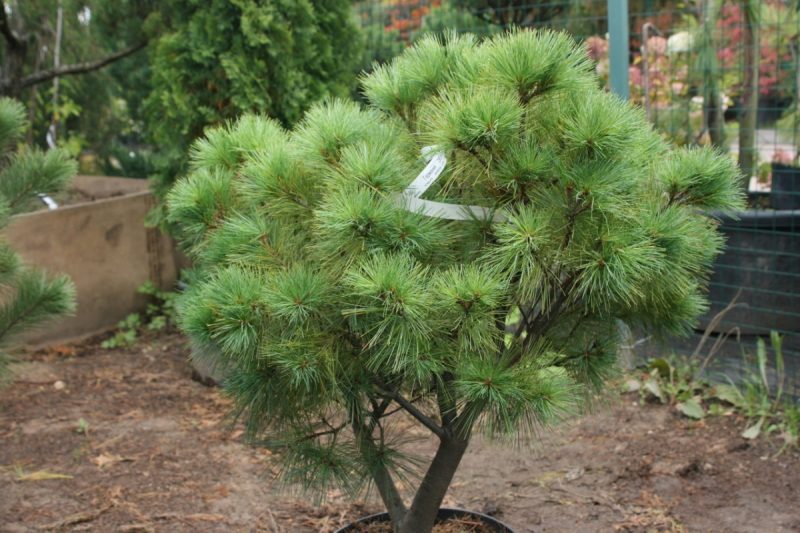
In North America, the Weimouth pine grows closer to the Atlantic coast, therefore it is called the white eastern pine.
This species is distinguished by the following features:
- tall - up to 60 meters in height;
- pyramidal or conical habit;
- long and soft bluish-green needles;
- young bark - smooth, light gray;
- the old bark is furrowed, darker, with a purple hue;
- cones are narrow-cylindrical, from 8 to 20 cm in length, hanging.
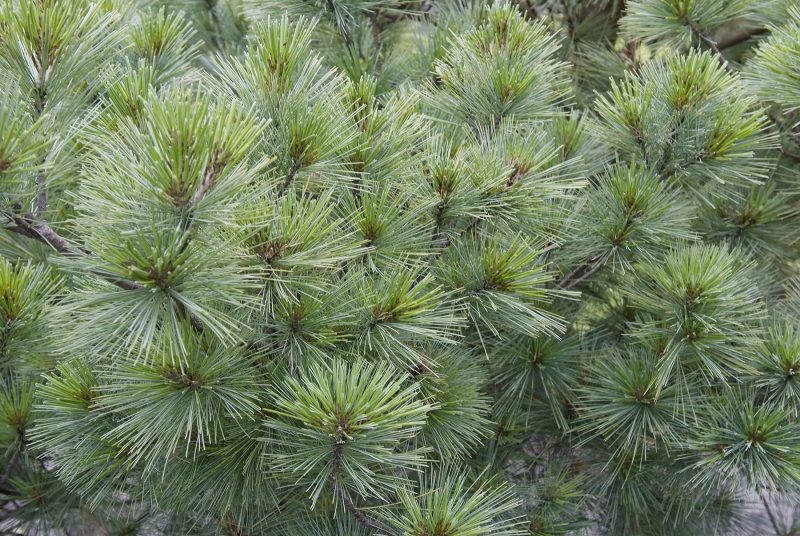
Thanks to the work of breeders, today you can meet different varieties of weymouth pine, adapted for growing in small areas:
- Alba variety - very quickly grows to 20 meters, has a wide-pyramidal crown with whitish needles;
- Blue Sheg variety - a dwarf form, not more than 1.5 meters tall, has a spherical habit and soft blue needles;
- Variety Makopin - a short plant up to 2 meters high with a low growth rate, bluish-green lush needles and spectacular long cones 20 cm long;
- Radiata variety - medium-sized plant, up to 4 meters in height, with a flattened plastic crown, dark green needles with a bluish tint;
- Fastigiata variety is a tall form with an average growth rate, a maximum height of 10 m, a narrow pyramidal habit, and silver-green needles;
- Minima variety is a dwarf bush-like form with needles that change color during the season, reaching a height of no more than 80 cm, and a width of up to 1.5 meters.
All varieties of weymouth pine are frost-resistant and belong to USDA zone III. They take root well in most Russian regions, with the exception of the Far North and the hot southern regions.
Technology and landing rules
White eastern pine does not impose large requirements on soil fertility. A plot with low-humus sandy soil is perfect for her. The main condition is the absence of waterlogging and good illumination. The acidity of the soil is preferably close to neutral, but the plants tolerate soil and soil with a pH of about 5 units.
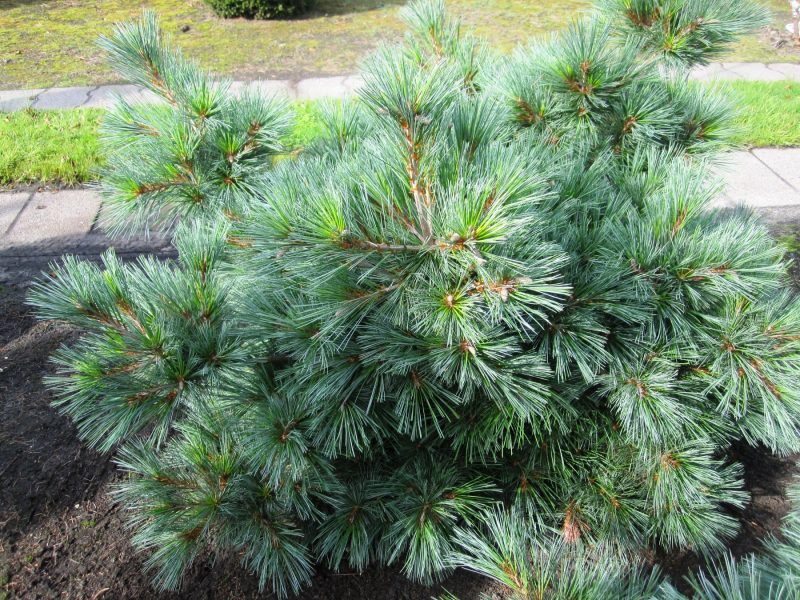
The best time for planting pine trees is the end of April or the beginning of September.
Planting pine seedlings is carried out according to the following technology:
- Prepare a landing pit, the dimensions of which should be slightly larger than the volume of the root system of the seedling.
- Lay a layer of rubble or expanded clay on the bottom of the pit as drainage.
- Prepare the soil mixture. On a clay site, it should consist of sod land and sand in a 2: 1 ratio. On the sandy - from the turfy earth and clay in the same proportion.
- Lay part of the soil mixture in the planting pit and expose the seedling, controlling the position of the root neck. At this stage, it should be above ground level.
- Fill the pit with the soil mixture, tightly compressing the roots of the seedling. After filling, check the position of the root neck - now it should be located at ground level.
- Water the seedlings abundantly and mulch the trunk circle with wood chips, bark or cones.
During spring planting, while the root system is taking root, it is advisable to prune the seedling so that the active sun does not dry out the shoots.
Care for white oriental pine in open ground
A common description of weymouth pine suggests that it is a very unpretentious plant. But this does not mean that he does not need any care.
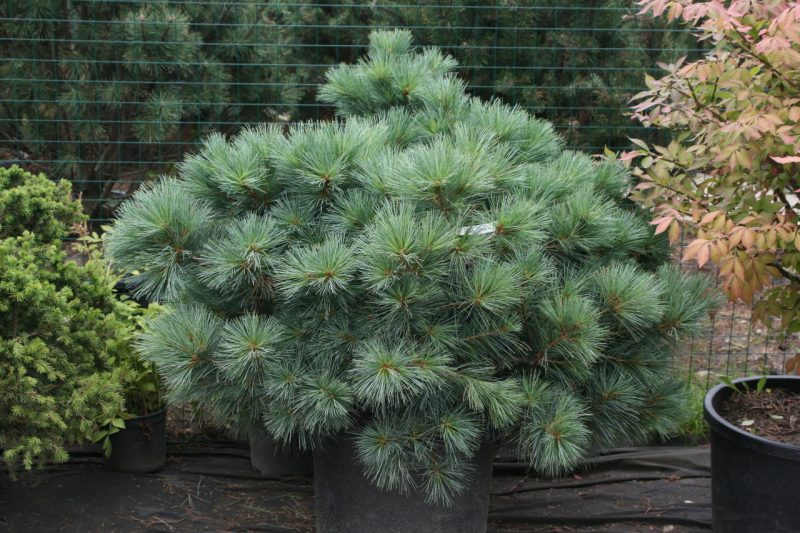
When growing white eastern pine, it is necessary to carry out the following activities:
- Watering. Seedlings are needed in the first year of life, especially in hot weather. Adult plants need additional watering only in a dry summer, 10 liters per tree.
- Top dressing. It is better to use ready-made fertilizers for conifers. Under young pines, they are applied once a year, in the spring. Adult trees need top dressing twice a year - in spring and late August.
- Mulching. This procedure not only helps to maintain optimal soil moisture and to get rid of the need for loosening it, but also creates optimal conditions for the life of useful soil flora. The best materials for mulching weymouth pine are coniferous litter, crushed bark, large chips, cones.
- Sanitary pruning. In spring and autumn, the tree must be inspected and removed dry, broken, twisted and diseased shoots.
The plant does not need any kind of protection against frosts; it perfectly winters without shelter. Only very young and weak seedlings make sense to cover with a spunbond cap, leaving small products below.
How to prune a tree
In addition to sanitary pruning, pine trees grown for decorative purposes can be crowned. By forming trimming, the desired shape of habit is achieved.
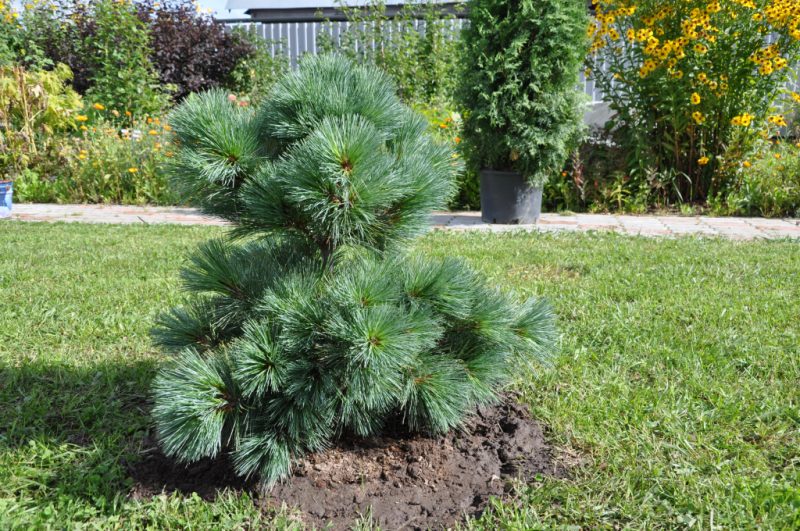
It is important to consider the following rules:
- Trim no earlier than the beginning of June. It is necessary to wait for the moment when the “candle” growths have already reached the maximum, but the needles have not yet begun to fluff.
- Do not cut the needle shoot. Damaged needles quickly dry and turn yellow, and the tree becomes sloppy.
- Lubricate small sections with a solution of copper sulfate. Large - garden var.
- Trim in cloudy weather.
Formative pruning - optional. Weymouth pine can only be grown with sanitary pruning, maintaining its natural shape.
Propagation Features
In nature, Weimouth pine propagates by seed. But at home it is troublesome to create optimal conditions for seed germination - they need stratification. In addition, seed propagation is not suitable for varietal pines.

Varietal specimens are best propagated by vaccination. As a stock, any five-coniferous pines are used - cedar, Korean, Rumelian, cedar elfin. Cuttings are prepared for stock. Vaccination is performed in a split on the top of the stock.
Pest and Disease Control
The tree is most susceptible to diseases such as bladder rust and sclerodial cancer:
| Disease | Symptoms | Methods of struggle |
|---|---|---|
| Sclerodium cancer | The death of the kidneys, partial browning and drying of the needles, the formation of necrotic ulcers on the cortex and their cracking, the appearance of a black fungus in their place. | Sanitary pruning, stripping of the bark, treatment with copper-containing fungicides - Oksih, Abiga-Peak. |
| Bubble rust | The formation of orange vesicles on shoots, thickening with wounds and milling, drying branches. | Sanitary pruning, fungicide treatment - “Topsin-M” and “Actellik” in turn. |
Pathogens of pine rust have a complex development cycle with a change of host. To prevent this disease, we must avoid the proximity of weymouth pine with bushes of currants and gooseberries.
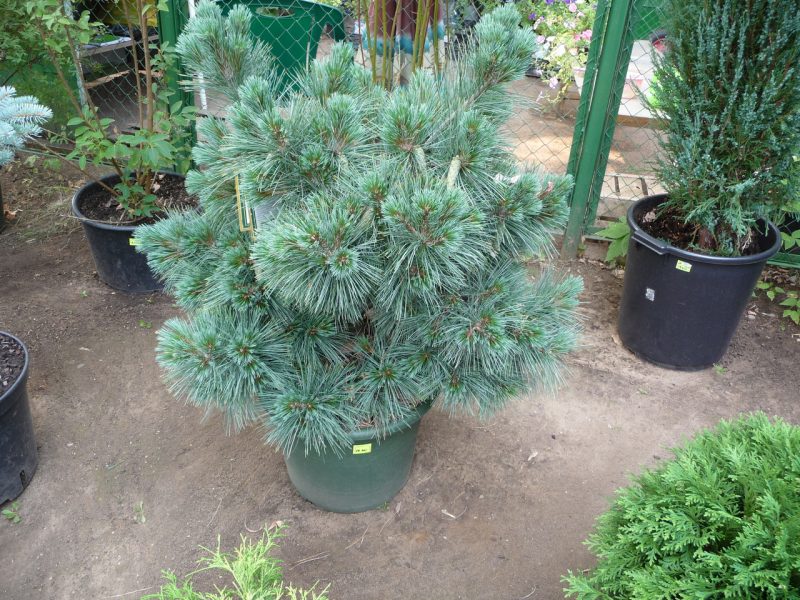
Eastern white pine can be damaged by various insects:
- pine hermes;
- large pine weevil;
- runaway;
- red pine sawfly.
If a lesion is detected, it is necessary to treat the plant with insecticides - Decis, Calypso, Confidor Maxi, Mospilan.
Weymouth pine wood application
Weymouth pine - one of the best building materials. Initially, it began to be bred in Europe for the construction of ships. Now at home, this plant is used to build light cottages.
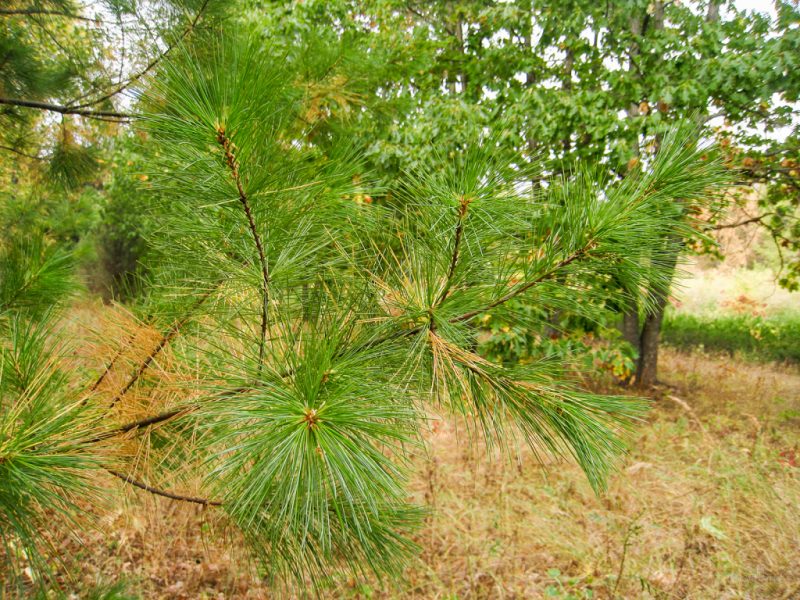
In Russia, the plant does not plant in volumes sufficient for industrial use. The main purpose is landscaping and forest reclamation. Forestry enterprises of the Nizhny Novgorod Region and Chuvashia are actively introducing it, as well as planting them in arboretums and reserves throughout Russia as a valuable decorative culture.












